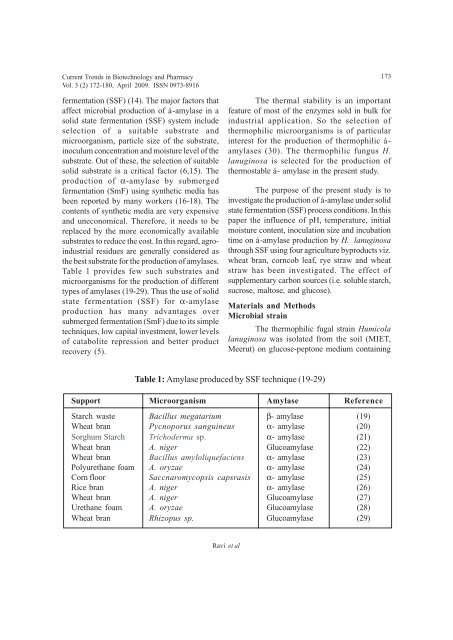April Journal-2009.p65 - Association of Biotechnology and Pharmacy
April Journal-2009.p65 - Association of Biotechnology and Pharmacy
April Journal-2009.p65 - Association of Biotechnology and Pharmacy
You also want an ePaper? Increase the reach of your titles
YUMPU automatically turns print PDFs into web optimized ePapers that Google loves.
Current Trends in <strong>Biotechnology</strong> <strong>and</strong> <strong>Pharmacy</strong><br />
Vol. 3 (2) 172-180, <strong>April</strong> 2009. ISSN 0973-8916<br />
fermentation (SSF) (14). The major factors that<br />
affect microbial production <strong>of</strong> á-amylase in a<br />
solid state fermentation (SSF) system include<br />
selection <strong>of</strong> a suitable substrate <strong>and</strong><br />
microorganism, particle size <strong>of</strong> the substrate,<br />
inoculum concentration <strong>and</strong> moisture level <strong>of</strong> the<br />
substrate. Out <strong>of</strong> these, the selection <strong>of</strong> suitable<br />
solid substrate is a critical factor (6,15). The<br />
production <strong>of</strong> α-amylase by submerged<br />
fermentation (SmF) using synthetic media has<br />
been reported by many workers (16-18). The<br />
contents <strong>of</strong> synthetic media are very expensive<br />
<strong>and</strong> uneconomical. Therefore, it needs to be<br />
replaced by the more economically available<br />
substrates to reduce the cost. In this regard, agroindustrial<br />
residues are generally considered as<br />
the best substrate for the production <strong>of</strong> amylases.<br />
Table 1 provides few such substrates <strong>and</strong><br />
microorganisms for the production <strong>of</strong> different<br />
types <strong>of</strong> amylases (19-29). Thus the use <strong>of</strong> solid<br />
state fermentation (SSF) for α-amylase<br />
production has many advantages over<br />
submerged fermentation (SmF) due to its simple<br />
techniques, low capital investment, lower levels<br />
<strong>of</strong> catabolite repression <strong>and</strong> better product<br />
recovery (5).<br />
173<br />
The thermal stability is an important<br />
feature <strong>of</strong> most <strong>of</strong> the enzymes sold in bulk for<br />
industrial application. So the selection <strong>of</strong><br />
thermophilic microorganisms is <strong>of</strong> particular<br />
interest for the production <strong>of</strong> thermophilic á-<br />
amylases (30). The thermophilic fungus H.<br />
lanuginosa is selected for the production <strong>of</strong><br />
thermostable á- amylase in the present study.<br />
The purpose <strong>of</strong> the present study is to<br />
investigate the production <strong>of</strong> á-amylase under solid<br />
state fermentation (SSF) process conditions. In this<br />
paper the influence <strong>of</strong> pH, temperature, initial<br />
moisture content, inoculation size <strong>and</strong> incubation<br />
time on á-amylase production by H. lanuginosa<br />
through SSF using four agriculture byproducts viz.<br />
wheat bran, corncob leaf, rye straw <strong>and</strong> wheat<br />
straw has been investigated. The effect <strong>of</strong><br />
supplementary carbon sources (i.e. soluble starch,<br />
sucrose, maltose, <strong>and</strong> glucose).<br />
Materials <strong>and</strong> Methods<br />
Microbial strain<br />
The thermophilic fugal strain Humicola<br />
lanuginosa was isolated from the soil (MIET,<br />
Meerut) on glucose-peptone medium containing<br />
Table 1: Amylase produced by SSF technique (19-29)<br />
Support Microorganism Amylase Reference<br />
Starch waste Bacillus megatarium β- amylase (19)<br />
Wheat bran Pycnoporus sanguineus α- amylase (20)<br />
Sorghum Starch Trichoderma sp. α- amylase (21)<br />
Wheat bran A. niger Glucoamylase (22)<br />
Wheat bran Bacillus amyloliquefaciens α- amylase (23)<br />
Polyurethane foam A. oryzae α- amylase (24)<br />
Corn floor Saccnaromycopsis capsrasis α- amylase (25)<br />
Rice bran A. niger α- amylase (26)<br />
Wheat bran A. niger Glucoamylase (27)<br />
Urethane foam A. oryzae Glucoamylase (28)<br />
Wheat bran Rhizopus sp. Glucoamylase (29)<br />
Ravi et al













